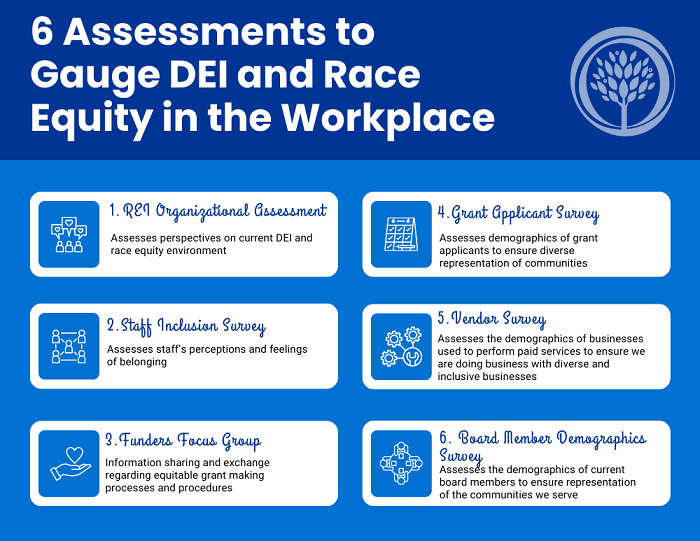In my last blog, Steps to Advance Race Equity in the Workplace, I shared the Wholespire strategy for integrating race equity into our operations. I also provided a timeline of how we got started and remained committed to incorporating diversity, equity, and inclusion (DEI) and race equity into all aspects of our work. In this post, I’ll explain one of our key steps toward advancing race equity in the workplace: completing an assessment.
What is an assessment and why is it important?
At Wholespire, we train youth advocates through The Healthy Young People Empowerment (HYPE) Project to identify, plan, and implement healthy eating and active living projects. In the HYPE training curriculum, there is a session that teaches youth the importance of assessing their focus area before starting a project so that they can have a clear understanding of the problem, whom it impacts, and how it shows up in everyday ways. This is the same approach that we used when planning our Race Equity and Inclusion (REI) strategies. We used several assessments to gather baseline data and provide guidance on our goal development. Eventually, they will be used to help us evaluate our work.
As a woman and a person of color, I personally find assessments to be a useful resource because they can help get everyone to a similar understanding of what problems exist. Now, if you are only looking for obvious examples of inequities in the workplace, such as hate speech and racial slurs, it may be hard to recognize where race inequity or racism exists in your organization. This could lead organizations to falsely believe that they should not have a plan to continuously assess and address equity within their organization.
In my last blog, I provided examples of the inequities that people of color may experience in the workplace related to raises, promotions and other income; equal pay; and a sense of belonging that are more subtle. Assessing can help us identify these more subtle examples.
Creating an Assessment
We really wanted to use the REI Workplace Guides to help guide our REI efforts because it was created by local partners, used by other organizations in South Carolina, and we participated in its development. When we looked for an existing assessment that would measure the indicators found in the REI Workplace Guides, we didn’t have much luck, so we created our own based on the guide’s 36 indicators. Additionally, we adopted and modified various other assessments that will be explained later in the blog.
Small non-profits may struggle with the time commitment required of a single full-time staff to create and modify assessments. Therefore, Wholespire sought assistance from a former HYPE team at Lexington School District One’s Center for Public Health and Advanced Medical Studies at White Knoll High School to help develop our REI Organizational Assessment.
We chose to collaborate with high school students and HYPE alumni because one of the long-term goals of The HYPE Project is to expose HYPE alumni to careers in public health and other aspects of community health improvement. We turned to the White Knoll High School HYPE alumni based on their successful HYPE project, the Fast Break breakfast program and the advanced learning program. We were confident that the students would grasp the concept of assessment and accept our challenge. After all, they learned about the importance of assessments during their HYPE training.
Six Assessments to Gauge DEI and Race Equity in the Workplace
The infographic below highlights the six assessments Wholespire used to establish goals and action steps for integrating race equity into the workplace.

Examples of Assessment Results
Our REI Organizational Assessment showed us where we are doing well and revealed areas that needed to be addressed. For example, on our staff inclusion survey employees indicated some of the areas we are doing well in are:
- Diversity, equity, and inclusion are important to our staff.
- Our staff feel respected and valued by leadership and teammates, despite their differences.
- Our staff can voice contrary opinions without fear of negative consequences.
- Wholespire shows that diversity, equity, and inclusion is important through its actions.
- My job performance is evaluated fairly.
The staff inclusion assessment also indicated areas of needed improvement, which became our starting point for goal development and action planning. Examples include:
- I do not feel encouraged to participate in diversity, equity, and inclusion professional development.
- I feel like my colleagues do not understand who I really am.
- Wholespire is not committed to improving the diversity of its employees.
- Wholespire’s policies or procedures do not encourage diversity, equity, and inclusion.
Overall, what we learned from the various assessments is that we needed to continue in the areas that we’re doing well, but to also start focusing on establishing and communicating organizational policies related to REI, encouraging professional development for leadership and staff, and improving staff interpersonal relationships to move closer toward a truly equitable organization. We also realized that internal communication is imperative to staff understanding our policies and procedures, so we’ve focused on improving the way we communicate with all staff.
As we continue to implement our strategies and move closer to reaching our goals, our plan is to reassess our efforts, evaluate the reassessment results, and revise any assessment tools or strategies to help us achieve our goals. If you want to learn more about the Wholespire race equity in the workplace journey, visit our DEI webpage. It has complete information about our framework, as well as resources to explore. You can also find race equity resources on Options for Action.
Race Equity in the Workplace Series
Part 1: DEI Insights
Part 2: Getting Started with Race Equity in the Workplace
Part 3: 6 Steps to Advance Race Equity in the Workplace
Part 4: How do you assess race equity in the workplace?

